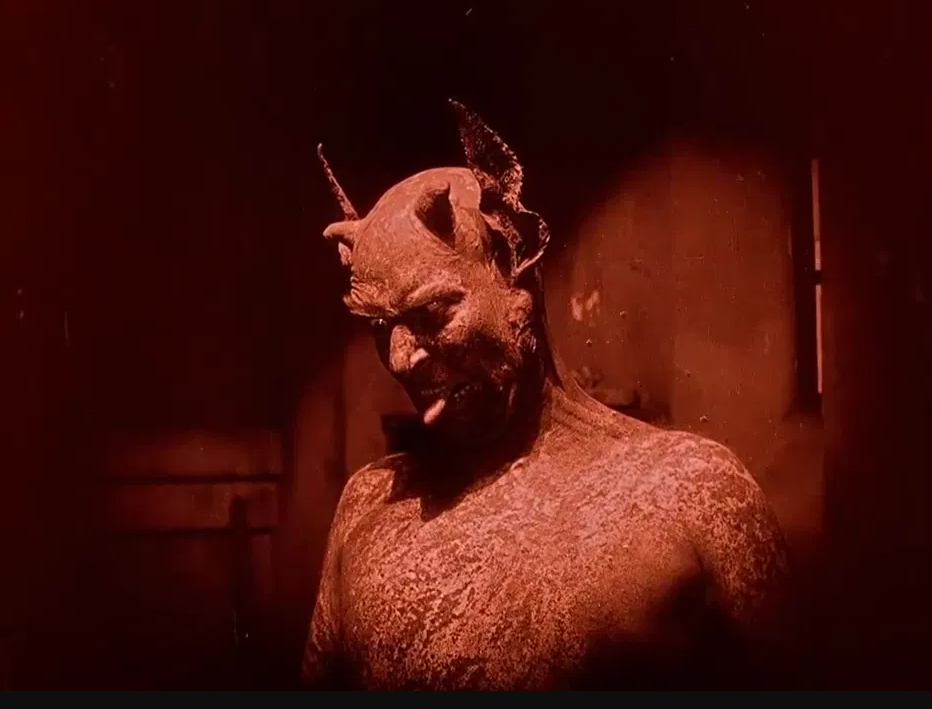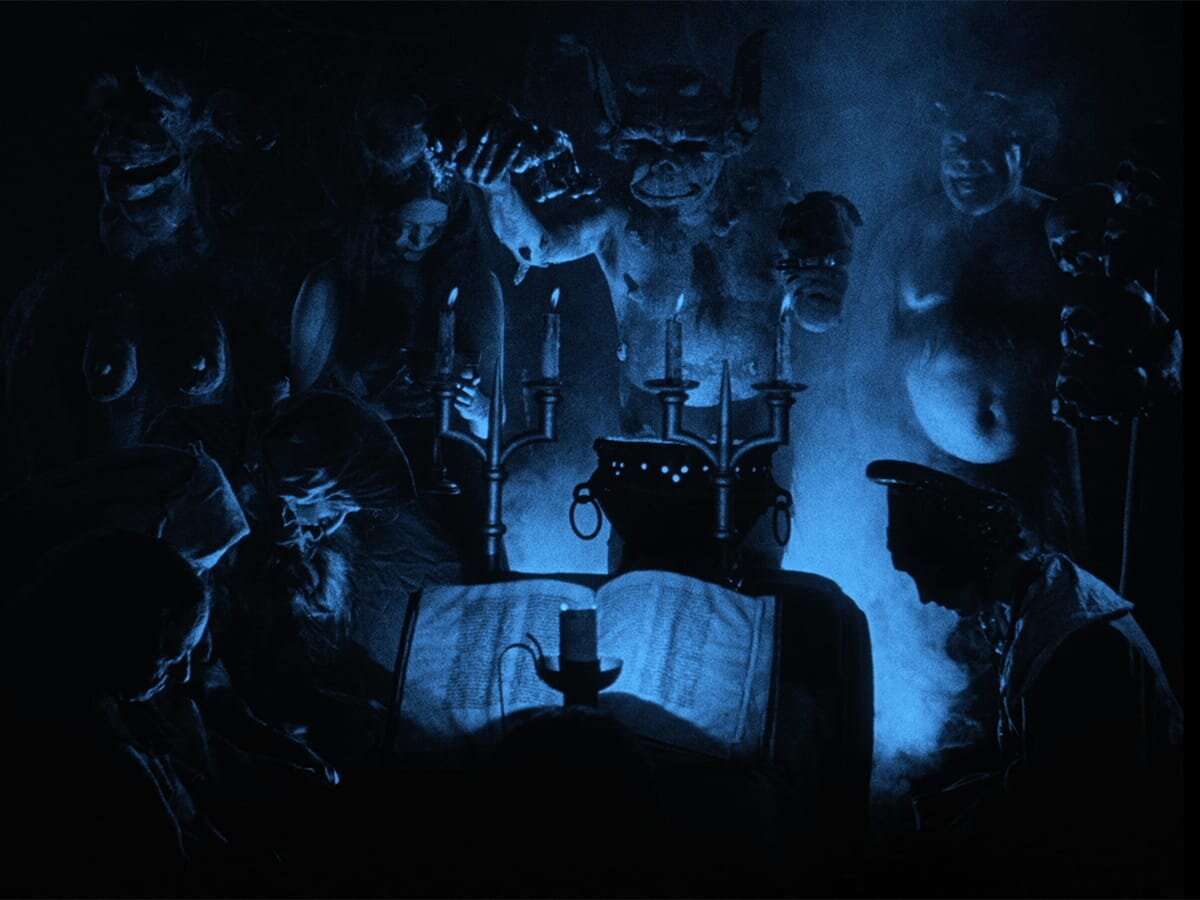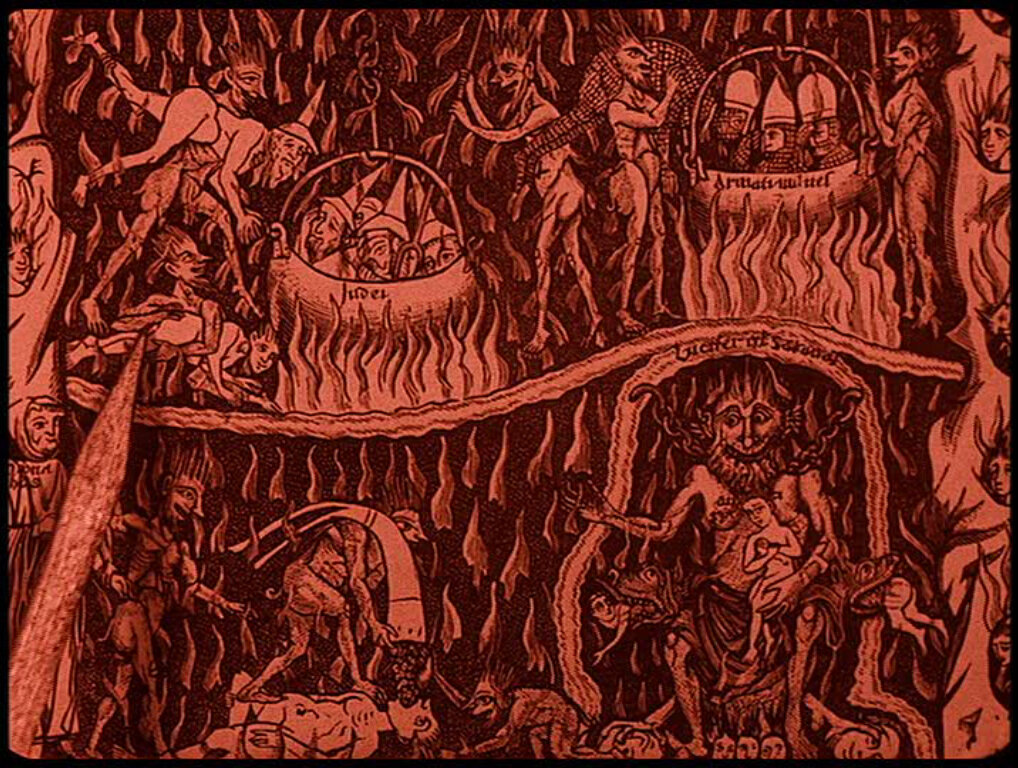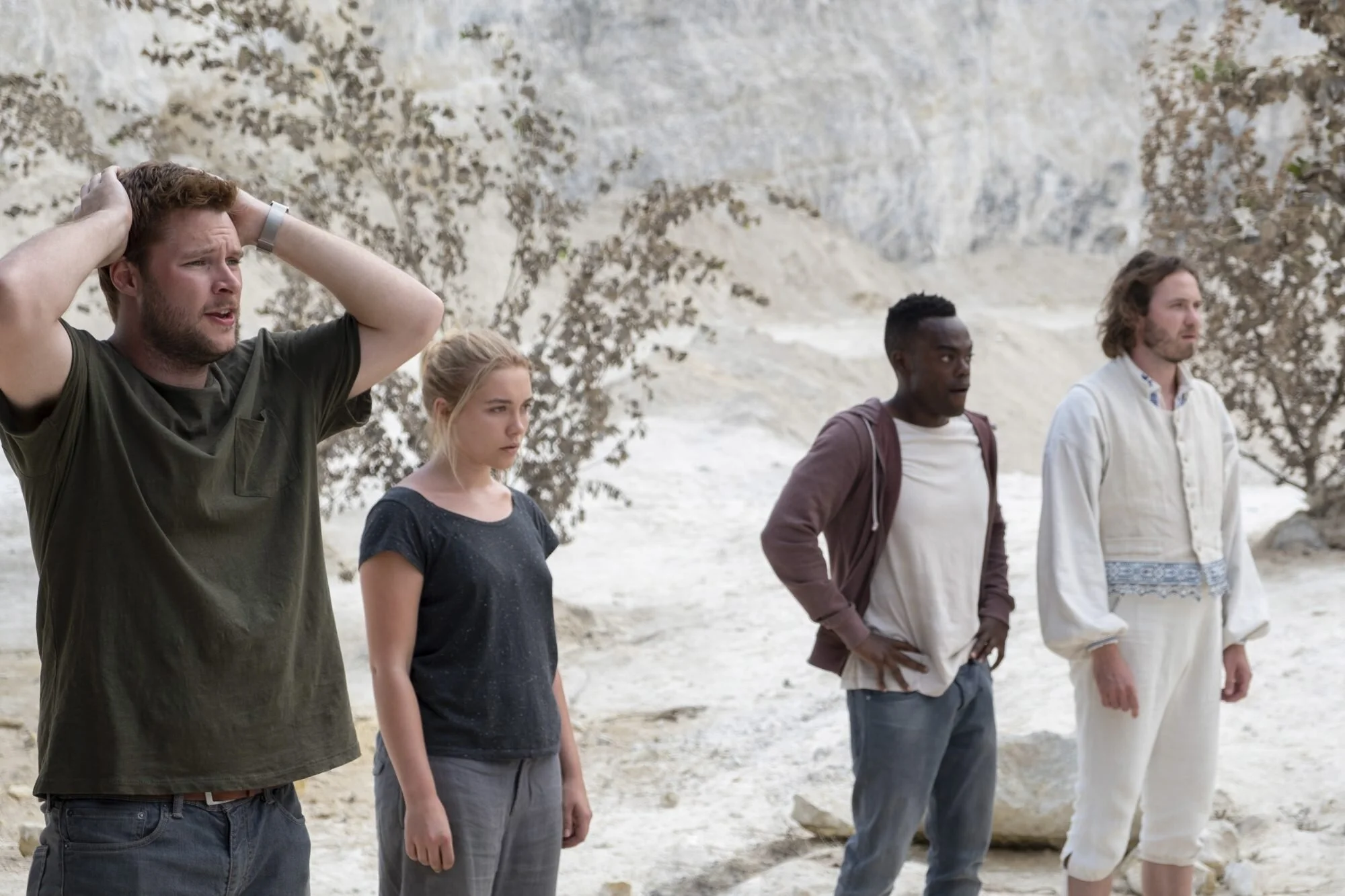Häxan & the Wrong Version of a Great Film
BEWARE SPOILERS: We go into every post assuming you’ve already watched the film being discussed.
* * *
Filmmaker Benjamin Christensen as Häxan’s Satan, who has an unusually vibratory tongue.
We wrap up a month of Pagan horror with Häxan, a unique silent film about medieval witch hunts. Normally, we wouldn’t call devil worship “Pagan,” nor would we necessarily call witchcraft “Pagan” (depends on what you mean by “witch”), and we’re not crazy about lumping witch movies and Satanic cult movies into the same folk horror subgenre as The Wicker Man (1973), Kill List (2011), and Midsommar (2019). But, we have to acknowledge that films involving Satanic cults and covens have had a huge influence on Pagan horror.
Plus, getting to talk about Benjamin Christensen’s landmark and enduring 1922 hybrid essay/docudrama Häxan in the context of all these films was too tempting to pass up.
We’re going to put this right up front: don’t watch the Wrong Version--and yes, it’s the Wrong Version. As of this publication (March 28, 2021), you can watch one of the Right Versions--meaning it maintains Christensen’s 1922 narration--on HBO Max. Other identifying features of Right Versions include: 1) it’s all red-looking (tinted that way because Satan) and later blue (because night time), 2) it’s around an hour and forty-six minutes, and 3) it has a lovely score, in the case of this particular Right Version, composed by Gillian Anderson (not Dana Scully; this is a different Gillian Anderson who makes music and has never, to our knowledge, hunted down monsters or aliens).
We will not provide a link to the Wrong Version lest you accidentally click it and think we directed you to this particular 1968 hatchet job. It’s black-and-white (not Satan- and night-time tinted, doing real damage to some of the visuals). Much of Christensen’s intertitles (the cards in silent films) are cut or re-interpreted, replaced with some downright offensive voiceover by the seminal Beat writer William S. Burroughs. Moreover, entire scenes are removed, cutting a half-hour of good material from the original.
There’s more rant to come on this, but the point is, don’t watch it. It’s a jazzed up, tonedeaf insult to its source material.
Some Background
Häxan blurs the line between fact and fiction in a way often described as a blend of documentary and dramatized horror, of appalling truth and indulgent spectacle. As we mention above, this Danish-Swedish co-production focuses on medieval witch hunts, which, according to Casper Tybjerg’s writing on the film for JSTOR Daily, Christensen considered to be “one of the biggest catastrophes in the history of mankind.” US gatekeepers at the time of the film’s making found its depiction of this catastrophe so extreme that they banned the film, whereas other countries heavily censored it.
(Some of the scenes really hold up in that regard--not that they deserve to be censored. That would be a weird stance for a horror blog to take. But it’s amazing how well these obviously dated special effects hold against modern computer-generated and practical effects.)
We’re in arthouse and silent film territory here, so it should go without saying that Häxan isn’t for everyone. Be prepared to sit, read, and enjoy the hybrid fiction-nonfiction edutainment and to give yourself over to Christensen’s heavily researched dramatization. If you do (and presumably, if you’re reading this, you already have, because spoilers), you’ll find a rich, wild, disturbing world filled with intricate, handmade sets, wildly expensive (for the time) special effects, and gorgeous artwork. A world that is often silly and horrifying and grotesque all at the same time.
Even if it was poorly received by some countries because of the explicit subject matter, Häxan is fascinating, built with real craftsmanship (aided by an unheard-of-at-the-time 1.5-2 million kronor, making it potentially the most expensive silent film in Scandinavian history). Writing for The Criterion Collection, Chris Fujiwara notes, after its release,
the film went on to spend decades in the purgatory of movies that are much mentioned but rarely seen; when Häxan was shown, it was often in a shortened 1968 version called [the Wrong Version, which you should not watch, and we will not name], prepared by filmmaker Antony Balch and narrated by William S. Burroughs. In recent years, benefiting from successive restorations and wider distribution, Häxan has taken its place among the prominent works of silent cinema.
So, like The Wicker Man, Häxan has left behind its own legacy, and lots of folks, including in some of the articles linked above, have written about Christensen’s ambition and creativity, often most concerned with that blurred line between fact and fiction, reality and fantasy. And that’s fascinating and cool, but it’s also said and done. So, rather than treading that already well-trod path, we’re going to take a few of the same steps and then branch off. Same starting point, new trail blazed.
Like we said, the film blends documentary and dramatization, along the lines of shows like Unsolved Mysteries, America’s Most Wanted, and other supernatural investigation and true crime shows that followed in their wake. But the thing we said before that is that Häxan is an essay, which is key to its integrity and its artfulness. The Wrong Version scraps all that in favor of what feels like a deeply insensitive, drugged-out History Channel documentary.
The Thing About Essays
Before you start thinking about language arts and English composition classes, which we assume will lead to your breaking out into a cold sweat, there’s a thing about essays that you have to understand.
They’re not always structured in that rigid thesis-statement-and-five-paragraph formula your English teacher may have taught you. They’re also not necessarily complicated jargony affairs that seem like they’re written in Pig Latin. See, there’s also personal essays, opinion pieces, and the feature articles you find online. Plus you’ve got these weird things called lyric essays, which sometimes get lumped in with these other weird things called prose poems. Plus there’s these articles we write here on this blog, which, similar to some other blogs, are also essays.
Point is, all of these forms of essay are commonly (though not always) written to entertain, to educate, or to art (as a verb, because art is a weird thing you can’t always call entertaining or educational). And they’re written from a particular perspective that’s engaging to read.
But then there are also video essays. They’re less common. Eric used to love this short film subscription series from The Believer called Wolphin that would sometimes include these really strange and pretty nonfiction films that sometimes had arguments, often felt poetic, and were always mulling over ideas, ruminating on images, and questioning their own points of view. It was very cool, and they should bring it back.
Häxan Is One of Those Weird Artsy Video Essay Thingies
Told in seven parts, Häxan outlines the history and atrocities of the medieval witch hunts.
In the lower left, Christensen notes, “A devil pours nasty oozing brimstone from a horn down a man’s throat".
Part 1 introduces the subject and lays the groundwork, offering information about witchcraft, demonology, and religious ideas about the world from ancient Persia, Egypt, and across Europe. This is the most scholarly part of the film, showing Christensen’s historical and folklore research, including woodcut imprints, whimsical and beautifully crafted dioramas, and “a strange old mechanical representation of hell” that is both horrifying and friggin’ awesome.
As recovering academics ourselves, we can’t get enough of this stuff. It’s a really wonderful glimpse into the ideas and depictions surrounding witches from the perspective of a filmmaker from the 1920s who loved the source material, appalling as the content was, and wanted to share it with the world. His argument about the barbarity of that content comes later.
Part 2 begins with the story of a woman named Karna (Ella la Cour) who brews a love potion to help a woman seduce a member of the clergy. Karna’s witch-ness, like other representations of witchcraft in the film, seems more an illustration of the fear people had of witches throughout medieval Europe than a representation of actual witchcraft. In contrast, the Wrong Version suggests that most, if not all, of the accused women are actual witches who betray their covens to monks dispatched by the Pope to hunt down and execute witches in the fifteenth century.
In Part 3, the local printer has contracted a sudden and mysterious illness, which the townsfolk “diagnose” after performing the surefire is-this-dude-bewitched? test: waving a ladle of molten lead over his body, throwing the lead into water afterward to see how it solidifies, and then “reading” the results in the shape of the lead. Turns out he’s bewitched! So, commenceth the witch hunt! By the end of Part 3, the monks have accused and arrested Maria the Weaver (Maren Pedersen, winkingly credited as “The Witch”), an old woman in the community whose only crimes are old age and homelessness (which, we don’t have to point out, are not crimes at all).
Maren Pedersen as Maria the Weaver: “Oh, learned men! How do you expect me to confess that which is not true?”
In Part 4, Maria is cajoled and tortured by the monks until she “confesses” that she’s a witch and gives up other witches in town. These scenes illustrate the bleak, hopeless, and (we recognize now) misogynistic fates of the accused in the name of the Church.
Part 5 follows Anna (Astrid Holm), one of the few women left in the community after accusations of witchcraft have spread through it like a plague--as Christensen notes, “every witch gives ten other witches away.” Like those before her, Anna is tortured and eventually tricked into a confession herself. (It’s actually not a confession, but really that’s beside the point because we’re talking men murdering women out of superstitious misogyny.)
In much of Part 6, Christensen moves away from dramatizations to describe various torture devices and interrogation techniques used by the monks to obtain confessions. These scenes manage to be exceptionally uncomfortable, but not because they offer up gory torture porn. All Christensen has to do is show how the devices move, slowly track the camera over each mechanism, and show them attached to human beings. The anticipation, the dread--your imagination does the work.
Finally, Part 7 brings us back to the 1920s. Christensen lays out the core of his argument, that the witch hunts were ignorant and superstitious barbarity, that some of these beliefs persist today, that many of the accused women were and are suffering from forms of “hysteria” and other mental and physical illnesses. Moreover, he implies, it’s our responsibility as a society to take care of these poor, suffering souls.
Okay okay, so those last two bits are sexist, paternalistic, and ableist. But at least they don’t betray a hatred of women or people with disabilities. Christensen is trying to make an argument for compassion. He had some ideas that, viewed today, don’t look great, but they’re at least understandable given that they came from 1922. That 1968 Wrong Version, however, is chock full of what feels like woman-hating witch propaganda spread by the medieval Church in a world where the medieval Church had the technology to make silent films.
Illusory Truth: Christensen’s Argument
The illusory truth effect is a psychological phenomenon that, as this super academic-y article from the Journal of Experimental Psychology explains, plagues even the most knowledgeable of humans. According to this simplified explanatory guide, which Meg had to pull up so Eric could understand it, the effect is shorthand for “how, when we hear the same false information repeated again and again, we often come to believe it is true.” (That’s not something any modern person in any civilized democratic society, especially in the United States, ever deals with, right?)
That’s essentially Christensen’s interpretation of the Church’s traveling band of murder monks in medieval Europe. Basically, they manifested the devil wherever they went and in so doing, became him. They, and the communities they infested, manifested witches in the bodies of innocent women to be tortured, gaslit, and murdered. Irrational superstition, stemming from our ignorance of mental and physical differences, made the devil and witches real. Essentially, being a woman meant you were never safe, and all women were the potential victims of Church-sponsored terrorism.
Why the 1968 Version Is Wrong
Burroughs and filmmaker Antony Balch removed much of the research and argument behind Häxan, instead opting to punch up the spectacle, apply a jazz score composed by Daniel Humair that often seems to mock the film, and remove Christensen’s methodically built argument to replace it with Burroughs telling us all about how witches are real, and it’s a good thing these monks killed them. The Wrong Version twists itself into a weird logical pretzel, trying at times to be mildly critical of the monks while also suggesting that ultimately they were doing important work.
It’s all spectacle, no soul. A cynical piece of medieval Church propaganda made in the mid-twentieth century.
Versions of Häxan That Are Right
A medieval conception of the cosmos.
Christensen spent two years crafting a film with extensive research, which he represented with care and love, and he built an argument that, in spite of this love, is deeply critical of the history his sources depict. (Again, acknowledging that his argument also had some ideas that look troubling today--because we’re super-enlightened in the twenty-first century and definitely have a lock on what’s right and wrong now…)
Much of what makes the film so special is tied to what has us all grumpy about a bad recut that happened over fifty years ago: Christensen’s research, his love for his source material, and the craftsmanship behind the film.
In an essay for SilentFilm.org, Laura Horak describes exactly what we mean about Christensen’s craftsmanship, focusing on the scene in the film when a coven of witches fly in silhouette over the countryside. Standard practice for a scene like this would have been to shoot the actual countryside from a moving train:
Instead, his technicians constructed an enormous model town on a giant carousel, which held more than 250 houses, each about six feet high. The carousel was turned by 20 men. The witches (more than 75) were filmed separately by a moving camera that tracked past them as an airplane engine generated wind. These shots, according to Tybjerg [who we cited earlier], were combined “using an experimental optical printer designed by Christensen’s cameraman.”
This is what makes Häxan so wonderful. The care that went into making something that feels both scholarly and (for the time) scandalous, both measured and indulgent. The love showing through as he points delicately at woodcuts and that “strange old mechanical representation of hell.” The words and dioramas used to explain ancient mythologies, religious beliefs, and superstition.
Häxan is spectacular and at times silly, but it’s also deeply earnest in its argument, full of reverence for its source material, and compassionate toward the women who suffered and died at the hands of ignorance, misogyny, and religious zealotry. The impulse to update the film is understandable, but it deserves to be treated as more than a tripped out Satan-fest. If Häxan is a poem, the Wrong Version is at best a bathroom wall limerick that robs the original of its art and its meaning.











